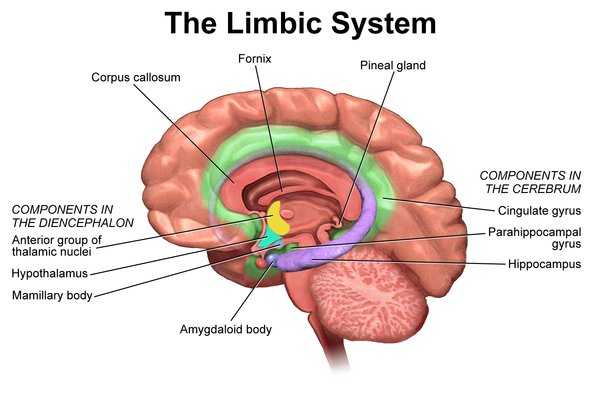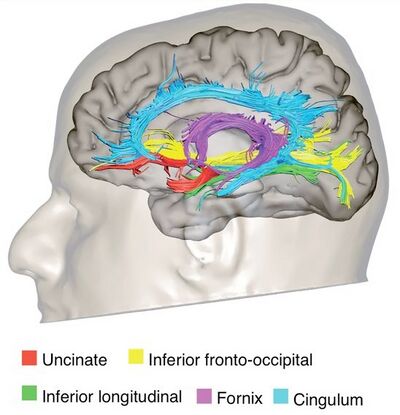Limbic System
Original Editor - Lucinda hampton
Top Contributors - Lucinda hampton, Jess Bell, Stacy Schiurring, Kim Jackson and Rucha Gadgil
Introduction to the Limbic System[edit | edit source]
The limbic system is involved in essential survival behaviours, such as feeding, reproduction, caring for offspring and our fight or flight response.[1]
It is a complex network of brain of structures that are located lateral to the thalamus, beneath the cerebral cortex and above the brainstem.[2] The limbic system supports various functions, including (1) emotion, (2) behaviour, (3) motivation, (4) long-term memory, (5) olfaction and (6) stress response.[3]
In evolutionary terms, it is one of the oldest parts of the brain and it "constitutes a functional concept, and is characterized by dense afferent projections from brainstem and forebrain nuclei, which contributes to behavioral modulation"[4]
Important Limbic Structures[edit | edit source]
There is still no consensus on all the structures that make up the limbic system,[4] but key structures include the amygdala, hippocampus, thalamus, hypothalamus, basal ganglia, and cingulate gyrus[2]
Amygdala[edit | edit source]
- A small almond-shaped structure; there is one located in each of the left and right temporal lobes
- Known as the emotional center of the brain, the amygdala is involved in evaluating the emotional valence of situations (e.g., happy, sad, scary)
- Assists the brain to recognise potential threats and helps prepare the body for fight-or-flight reactions by increasing heart and breathing rate
- Also responsible for learning on the basis of reward or punishment[5]
- Due to its close proximity to the hippocampus, the amygdala is involved in the modulation of memory consolidation, particularly emotionally-laden memories. Emotional arousal following a learning event influences the strength of the subsequent memory of that event, so that greater emotional arousal following a learning event enhances a person’s retention of that memory[5].
Hippocampus[edit | edit source]
- Found deep in the temporal lobe, and is shaped like a seahorse
- Consists of two horns curving back from the amygdala
- Psychologists and neuroscientists dispute the precise role of the hippocampus, but generally agree that it plays an essential role in the formation of new memories about past experiences[6]
Thalamus and Hypothalamus[edit | edit source]
- Both associated with changes in emotional reactivity.
- The thalamus (sensory “way-station” for the rest of the brain) is primarily important due to its connections with other limbic-system structures.
- The hypothalamus is a small part of the brain located just below the thalamus on both sides of the third ventricle. Lesions of the hypothalamus interfere with several unconscious functions (such as respiration and metabolism) and motivated behaviors like sexuality, combativeness, and hunger.
- The lateral parts of the hypothalamus seem to be involved with pleasure and rage, while the medial part is linked to aversion, displeasure, and a tendency for uncontrollable and loud laughter.[7]
Cingulate Gyrus[edit | edit source]
- Located in the medial side of the brain next to the corpus callosum
- Frontal portion of the cingulate gyrus links smells and sights with pleasant memories of previous emotions
- Also participates in our emotional reaction to pain and in the regulation of aggressive behaviour[8]
Basal Ganglia[edit | edit source]
- A group of nuclei lying deep in the subcortical white matter of the frontal lobes that organises motor behaviour[2]
Limbic System Disorders[edit | edit source]
Disorders or behaviours that are related to limbic system dysfunction/damage (e.g. traumatic brain injuries or aging) include:
- Disinhibited behaviour: Person does not consider the risk of behaviours and ignores social conventions/rules.
- Increased anger and violence: Commonly tied to amygdala damage
- Hyperarousal: Amygdala damage, or damage to parts of the brain connected to the amygdala, can cause increased fear and anxiety. Anxiety disorders are sometimes treated with drugs that target areas of the amygdala to decrease fear-based emotions.
- Hypoarousal: Can cause low energy or lack of drive and motivation.
- Hyperorality/Kluver-Bucy Syndrome: This is characterized by amygdala damage that can lead to increased drive for pleasure, hypersexuality, disinhibited behaviour and insertion of inappropriate objects in the mouth.
- Appetite dysregulation: Destructive behaviours tied to hyperorality or thalamus dysfunction can include overeating, binge eating or emotional eating.
- Trouble forming memories: Hippocampal damage can include short-term or long-term memory loss. Learning is often greatly impacted by hippocampal damage, as learning it depends on memory.
- Alzheimer’s disease: Research shows that people with Alzheimer’s and memory loss usually have experienced damage to the hippocampus[9]. This causes memory loss, disorientation and changes in moods. Some of the ways that the hippocampus can become damaged include free radical damage/oxidative stress, oxygen starvation (hypoxia), strokes or seizures/epilepsy.
Puberty and the Limbic System[edit | edit source]
Puberty is the beginning of major changes in the limbic system[10].
- The amygdala is thought to connect sensory information to emotional responses. Its development, along with hormonal changes, may give rise to newly intense experiences of rage, fear, aggression (including toward oneself), excitement and sexual attraction[3].
- Over the course of adolescence, the limbic system gradually comes under greater control of the prefrontal cortex (an area associated with planning, impulse control and higher order thought).
- As additional areas of the brain start to help process emotion, older teens gain some equilibrium and have an easier time interpreting others. But until then, they often misread others e.g. teachers and parents.
References[edit | edit source]
- ↑ Queensland Brain Institute. The limbic system. Available from: https://qbi.uq.edu.au/brain/brain-anatomy/limbic-system (last accessed 30 June 2024).
- ↑ 2.0 2.1 2.2 Torrico TJ, Abdijadid S. Neuroanatomy, Limbic System. [Updated 2023 Jul 17]. In: StatPearls [Internet]. Treasure Island (FL): StatPearls Publishing; 2024 Jan-. Available from: https://www.ncbi.nlm.nih.gov/books/NBK538491/
- ↑ 3.0 3.1 Martin JH. The limbic system and cerebral circuits for reward, emotions, and memory. In: Neuroanatomy: Text and Atlas. 5th ed. McGraw Hill, 2021.
- ↑ 4.0 4.1 Banwinkler M, Theis H, Prange S, van Eimeren T. Imaging the limbic system in Parkinson's disease-a review of limbic pathology and clinical symptoms. Brain Sci. 2022 Sep 15;12(9):1248.
- ↑ 5.0 5.1 Rajmohan V, Mohandas E. The limbic system. Indian J Psychiatry. 2007;49(2):132-139.
- ↑ Rubin RD, Watson PD, Duff MC, Cohen NJ. The role of the hippocampus in flexible cognition and social behavior. Front Hum Neurosci. 2014;8:742.
- ↑ Ackerman S. Discovering the Brain. Washington (DC): National Academies Press (US); 1992. 2, Major Structures and Functions of the Brain.
- ↑ Jumah FR, Dossani RH. Neuroanatomy, Cingulate Cortex. [Updated 2022 Dec 6]. In: StatPearls [Internet]. Treasure Island (FL): StatPearls Publishing
- ↑ Rao YL, Ganaraja B, Murlimanju BV, Joy T, Krishnamurthy A, Agrawal A. Hippocampus and its involvement in Alzheimer's disease: a review. 3 Biotech. 2022;12(2):55. doi:10.1007/s13205-022-03123-4
- ↑ Casey BJ, Jones RM, Hare TA. The adolescent brain. Ann N Y Acad Sci. 2008;1124:111-126. doi:10.1196/annals.1440.010








